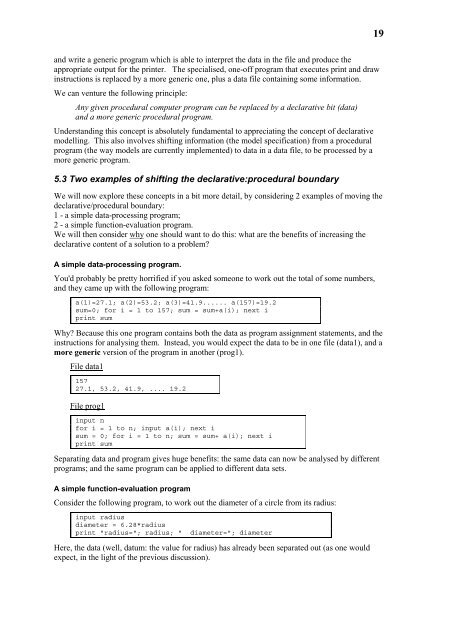pdf: 600KB - Potsdam Institute for Climate Impact Research
pdf: 600KB - Potsdam Institute for Climate Impact Research
pdf: 600KB - Potsdam Institute for Climate Impact Research
You also want an ePaper? Increase the reach of your titles
YUMPU automatically turns print PDFs into web optimized ePapers that Google loves.
19<br />
and write a generic program which is able to interpret the data in the file and produce the<br />
appropriate output <strong>for</strong> the printer. The specialised, one-off program that executes print and draw<br />
instructions is replaced by a more generic one, plus a data file containing some in<strong>for</strong>mation.<br />
We can venture the following principle:<br />
Any given procedural computer program can be replaced by a declarative bit (data)<br />
and a more generic procedural program.<br />
Understanding this concept is absolutely fundamental to appreciating the concept of declarative<br />
modelling. This also involves shifting in<strong>for</strong>mation (the model specification) from a procedural<br />
program (the way models are currently implemented) to data in a data file, to be processed by a<br />
more generic program.<br />
5.3 Two examples of shifting the declarative:procedural boundary<br />
We will now explore these concepts in a bit more detail, by considering 2 examples of moving the<br />
declarative/procedural boundary:<br />
1 - a simple data-processing program;<br />
2 - a simple function-evaluation program.<br />
We will then consider why one should want to do this: what are the benefits of increasing the<br />
declarative content of a solution to a problem?<br />
A simple data-processing program.<br />
You'd probably be pretty horrified if you asked someone to work out the total of some numbers,<br />
and they came up with the following program:<br />
a(1)=27.1; a(2)=53.2; a(3)=41.9...... a(157)=19.2<br />
sum=0; <strong>for</strong> i = 1 to 157; sum = sum+a(i); next i<br />
print sum<br />
Why? Because this one program contains both the data as program assignment statements, and the<br />
instructions <strong>for</strong> analysing them. Instead, you would expect the data to be in one file (data1), and a<br />
more generic version of the program in another (prog1).<br />
File data1<br />
157<br />
27.1, 53.2, 41.9, .... 19.2<br />
File prog1<br />
input n<br />
<strong>for</strong> i = 1 to n; input a(i); next i<br />
sum = 0; <strong>for</strong> i = 1 to n; sum = sum+ a(i); next i<br />
print sum<br />
Separating data and program gives huge benefits: the same data can now be analysed by different<br />
programs; and the same program can be applied to different data sets.<br />
A simple function-evaluation program<br />
Consider the following program, to work out the diameter of a circle from its radius:<br />
input radius<br />
diameter = 6.28*radius<br />
print "radius="; radius; " diameter="; diameter<br />
Here, the data (well, datum: the value <strong>for</strong> radius) has already been separated out (as one would<br />
expect, in the light of the previous discussion).
















